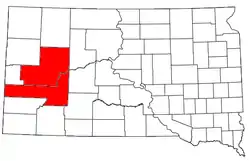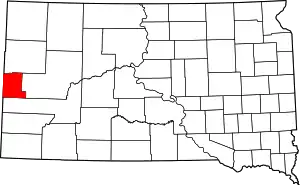Rapid City, South Dakota metropolitan area
The Rapid City-Spearfish, SD combined statistical area, as defined by the United States Census Bureau, consists of the Rapid City, SD metropolitan statistical area and Spearfish, SD micropolitan statistical area. Anchored by the city of Rapid City, the area corresponds to the entirety of Pennington, Meade, and Lawrence counties in the state of South Dakota. As of the 2020 census, the CSA had a population of 164,842 (2021 estimate placed the population at 168,144).[1]


Counties
Communities
Places with more than 50,000 inhabitants
- Rapid City (Principal city)
Places with 1,000 to 20,000 inhabitants
- Blackhawk (census-designated place)
- Box Elder
- Colonial Pine Hills (census-designated place)
- Deadwood
- Ellsworth AFB (census-designated place)
- Lead
- Rapid Valley (census-designated place)
- Spearfish
- Sturgis
- Summerset
Places with 500 to 1,000 inhabitants
- Ashland Heights (census-designated place)
- Green Valley (census-designated place)
- Hill City
- New Underwood
- Wall
- Whitewood
Unincorporated places
- Caputa
- Johnson Siding
- Owanka
- Rockerville
- Scenic
- Silver City
- Three Forks
- Wicksville
Demographics
Note: these statistics pertain to the Rapid City, SD metropolitan statistical area only.
2010
The ethnic makeup of the MSA, according to the 2010 U.S. Census, was the following:
- 85.26% White
- 8.19% Native American
- 1.08% Black
- 0.96% Asian
- >0.01% Native Hawaiian or Pacific Islander
- 3.63% Two or more races
- 0.80% Other races
- 3.63% Hispanic or Latino (of any race)
As of the census of 2010, there were 126,382 people, 51,154 households, and 33,390 families residing in the MSA. The population density was 20.2 people per square mile (7.8/km2). There were 55,949 housing units at an average density of 8.9 per square mile (3.4/km2). 27.9% were of German, 7.2% Irish, 6.7% Norwegian, and 5.2% English ancestry.
There were 51,154 households, out of which 32.0% had children under the age of 18 living with them, 49.2% were married couples living together, 11.2% had a female householder with no husband present, and 34.7% were non-families. 28.0% of all households were made up of individuals, and 9.4% had someone living alone who was 65 years of age or older. The average household size was 2.45 and the average family size was 2.93.
2000
As of the census[2] of 2000, there were 112,818 people, 43,446 households, and 29,978 families residing within the MSA. The racial makeup of the MSA was 87.98% White, 0.99% African American, 6.79% Native American, 0.82% Asian, 0.06% Pacific Islander, 0.67% from other races, and 2.69% from two or more races. Hispanic or Latino of any race were 2.53% of the population.
The median income for a household in the MSA was $37,239, and the median income for a family was $42,667. Males had a median income of $28,590 versus $21,029 for females. The per capita income for the MSA was $18,309.
References
- "Table 1. Annual Estimates of the Population of Metropolitan and Micropolitan Statistical Areas: April 1, 2010 to July 1, 2014 (CBSA-EST2009-01)" (CSV). 2009 Population Estimates. United States Census Bureau, Population Division. 2015-06-21. Retrieved 2015-06-21.
- "U.S. Census website". United States Census Bureau. Retrieved 2008-01-31.